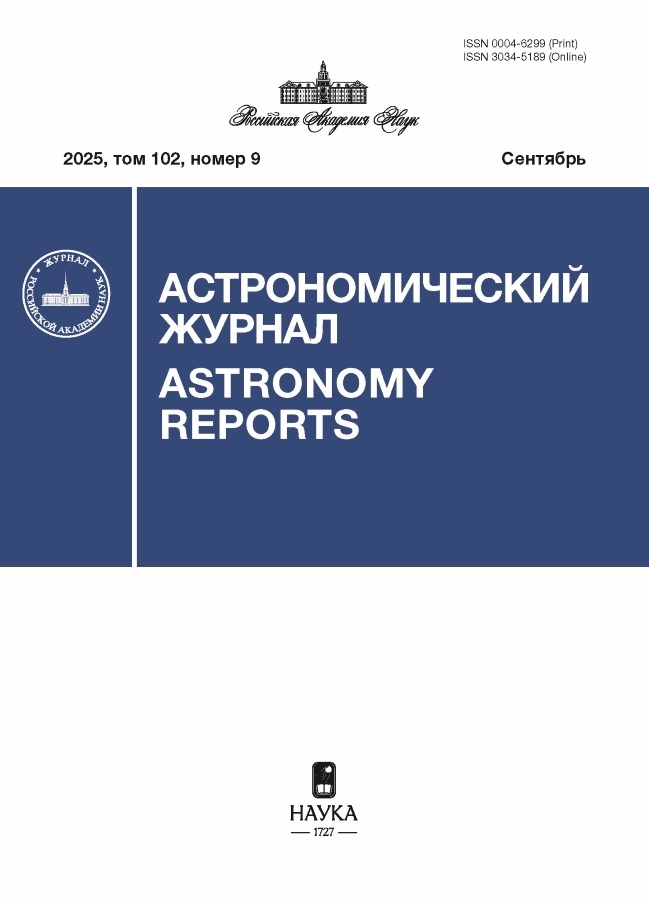Nature of quasi-periodic radiative pulsations in the rope flux models of flares
- Authors: Solov’ev A.A.1
-
Affiliations:
- Main (Pulkovo) Astronomical Observatory of the RAS
- Issue: Vol 102, No 9 (2025)
- Pages: 821-832
- Section: Articles
- URL: https://rjmseer.com/0004-6299/article/view/695915
- DOI: https://doi.org/10.31857/S0004629925090077
- ID: 695915
Cite item
Abstract
Rope flux models of solar flares associate the phenomenon of quasi-periodic pulsations of flare radiation with a parametric catastrophe that occurs when the top of a twisted magnetic loop enters the corona. A sharp decrease in external pressure leads to the longitudinal magnetic field of a force-free flux rope tending to zero on the magnetic surface where the current changes sign, and the density of the azimuthal current and the force-free parameter begin to grow indefinitely near this surface, approaching a break. The current velocity of electrons here will inevitably exceed the speed of ion sound, and plasma instability will arise. Scattering of electrons on ion-acoustic plasmons will sharply decrease the plasma conductivity and cause rapid, flare dissipation of the magnetic energy of the rope, i.e. decrease in the amplitude of the field and currents and expansion of the rope cross-section. This is how the first peak of the flare radiation will be formed. In this case, the torque applied to each section of the rope will be greatly weakened in the energy release region. In equilibrium, the torque should be the same along the entire length of the loop, so there will be a transfer of the azimuthal flux by Alfven waves from the loop legs to the top. Alignment of the torque along the rope axis will return the rope to its original state, after which the second peak of the flare radiation is formed, and the process is repeated several times until the reserve of free magnetic energy associated with the currents in the entire loop decreases significantly. The oscillations of the rope cross-section accompanying the peaks of its radiation represent a specific type of fluctuations of a system with time-varying rigidity: in them the magnetic field intensity, providing the restoring force, changes greatly. Calculation of such oscillations allows achieving not only qualitative but also quantitative correspondence between the theoretical results and observational data.
About the authors
A. A. Solov’ev
Main (Pulkovo) Astronomical Observatory of the RAS
Email: solov@gaoran.ru
St. Petersburg, Russia
References
- E.G. Kupriyanova, V.F. Melnikov, V.M. Nakariakov, К. Shibasaki, Solar Phys. 267, 329–342 (2010).
- D.Y. Kolotkov, V.M. Nakariakov, E.G. Kupriyanova, H. Ratcliffe, K. Shibasaki, Astron. and Astrophys. 574, A53 (2015).
- I.V. Zimovets, J.A. McLaughlin, A.K. Srivastava, et al., Space Science Reviews 217, 66 (2021).
- A. Inglis, L. Hayes, S. Guidoni et al., Bulletin of the AAS 55, 3, 181 (2023).
- А.А. Solov’ev, K. Murawski, Astrophys. аnd Space Science 350, 11 (2014).
- A.A. Solov’ev, E.A. Kirichek, Monthly Not. Roy. Astron. Soc. 505, 4406–4416 (2021).
- A.A. Solov’ev, E.A. Kirichek, Astronomy Letters 49, 5, 256–268 (2023).
- A.A. Solov’ev and E.A. Kirichek, Astronomy Letters 51, №9, 50–58 (2024).
- A.A. Solov’ev, Monthly Not. Roy. Astron. Soc. 515, 4, 4981–4989 (2022).
- A.A. Solov’ev, O.A. Korolkova, E.A. Kirichek, Geomagnetism and Aeronomy 63, 8, 10–25 (2023).
- E.N. Parker Cosmical Magnetic Fields. Part 1 (Clarendon Press, Oxford, 1979).
- E.N. Parker Conversations on Electric and Magnetic Field in the Cosmos (Princeton Univ. Press, Princeton, NJ, 2007).
- Б.Б. Кадомцев Пересоединение силовых линий в магнитной гидродинамике (М.: Наука, в сб. “Нелинейные волны” под ред. А.В. Гапонова-Грехова, 131–163, 1979).
- В.Д. Шафранов Равновесие плазмы в магнитном поле. Вопросы теории плазмы (М. Атомиздат, вып. 2, 92–132, 1962).
- Л.Д. Ландау, Е.М. Лифшиц Электродинамика сплошных сред. Том 8 (М.: Физматлит. 2003).
- A.A. Solov’ev, Astronomy Reports 101, 6, 565–574 (2024).
- Л.А. Арцимович, Р.З. Сагдеев Физика плазмы для физиков (М.: Атомиздат, 1979).
- G.D. Fleishman, E.G. Dale, B.Chen, et al., Science 367, 278–280 (2020).
- G.D. Fleishman, G.M. Nita, B. Chen, et al., Nature 606, 674–677 (2022).
- A.H. Nayfeh Introduction to Perturbation Techniques (New York, 1981).
- S.R. Kane, K. Kai, T. Kosugi, S. Enome, P.B. Landecker, D.L. McKenzie, Astrophys. J. 271, 376 (1983).
- S. Krucker, M. Battaglia, P.J. Cargill, et al., Astron. and Astrophys. 16, 155–208 (2008).
Supplementary files










